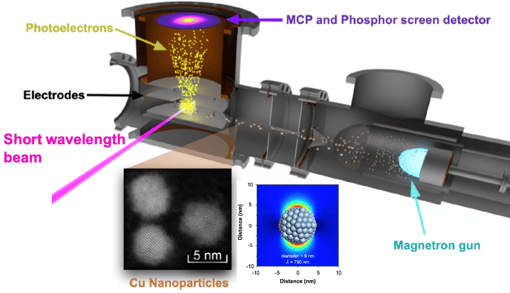Capturing charge, spin and phonon dynamics and couplings in isolated nanoparticles
Nanoparticles exhibit a surface-area-to-volume ratio many orders of magnitude higher than bulk materials, allowing them to serve as powerful catalysts for chemical reactions, both in the laboratory and as atmospheric aerosols. Such surface-catalyzed chemical reactions often involve molecular motions that take place on femtosecond and picosecond timescales, with associated electronic dynamics that can occur on attosecond time scales. To capture and understand these dynamics, new experimental techniques are needed to probe nanoparticles on femtosecond-to-attosecond time scales. Furthermore, theoretical models of nanoparticle surface dynamics are best validated with measurements performed in the absence of solvents or ligands.
Some KMLabs customers have developed a unique apparatus to produce, excite and probe fully isolated nanoparticles of varying composition. They combine KMLabs harmonic generation technology to produce ultrashort pulses of UV to EUV light with a velocity-map-imaging (VMI) photoelectron spectrometer to provide high electron-collection efficiency, and a magnetron source to synthesize monodisperse nanoparticles in vacuum. This setup has been used to study excited-state solvated electrons in oleylamine nanodroplets, and to study electron phonon couplings and shock waves in ground state and excited nanoparticles, nanoplasmas and small molecules.
Related Publications
- Q. Nguyen et al.,, “Mapping electron-phonon coupling and hot electron cooling in copper nanoparticles in the warm-dense matter regime”, submitted (2020).
- D. Couch, Q. Nguyen, A. Liu, D. Hickstein, H. Kapteyn, M. Murnane, N. Labbe, "Detection of the keto-enol tautomerization in acetaldehyde, acetone, cyclohexanone, and methyl vinyl ketone with a novel VUV light source", Proc. Combustion Institute, in press (2020).
- W. Peters, D. Couch, B. Mignolet, X. Shi, Q. Nguyen, R. Fortenberry, H. Bernhard Schlegel, F. Remacle, H. Kapteyn, M. Murnane, W. Li, “Ultrafast 25fs relaxation in highly excited states of methyl azide mediated by strong nonadiabatic coupling,” PNAS 114 (52), E11072 (2017). https://doi.org/10.1073/pnas.1712566114
- J.L. Ellis, D.D. Hickstein, W. Xiong, F. Dollar, B.B. Palm, K.E. Keister, K.M. Dorney, C. Ding, T. Fan, M.B. Wilker, K.J. Schnitzenbaumer, G. Dukovic, J.L. Jimenez, H.C. Kapteyn, M.M. Murnane, “Materials Properties and Solvated Electron Dynamics of Isolated Nanoparticles and Nanodroplets Probed with Ultrafast Extreme Ultraviolet Beams,” Journal of Physical Chemistry Letters 7 (4), 609–615 (2016).
- Jennifer L. Ellis, Kyle J. Schnitzenbaumer, Daniel Hickstein, Molly B. Beernink, Brett B. Palm, Jose L. Jimenez, Gordana Dukovic, Henry C. Kapteyn, Margaret M. Murnane, Wei Xiong, “Revealing solvent effects on charge transfer between quantum dots and surface adsorbates,” JACS 137 (11), 3759–3762 (2015).
- Daniel D. Hickstein, Franklin Dollar, Jennifer L. Ellis, Kyle J. Schnitzenbaumer, K. Ellen Keister, George M. Petrov, Chengyuan Ding, Brett B. Palm4, Jim A. Gaffney, Mark E. Foord, Stephen B. Libby, Gordana Dukovic, Jose L. Jimenez, Henry C. Kapteyn, Margaret M. Murnane, Wei Xiong, “Mapping Nanoscale Absorption of Femtosecond Laser Pulses using Plasma Explosion Imaging,” ACS Nano 8, 8810 (2014). (DOI: 10.1021/nn503199v)
- D.D. Hickstein, W. Xiong, F. Dollar, J.A. Gaffney, M.E. Foord, G.M. Petrov, B.B. Palm, K.E. Keister, J.L. Ellis, C. Ding, S.B. Libby, J.L. Jimenez, H.C. Kapteyn, M.M. Murnane, “Observation and control of shock waves in individual nanoplasmas,” Physical Review Letters 112, 115004 (2014).
- W. Xiong, D. Hickstein, K. Schnitzenbaumer, J. Ellis, B. Palm, K. Keister, L. Miaja-Avila, G. Dukovic, J. Jimenez, M. Murnane, H. Kapteyn, “Photoelectron spectroscopy of CdSe nanocrystals in the gas phase: a direct measure of the evanescent electron wavefunction of quantum dots,” Nano Letters 13 (6), 2924–2930 (2013).
